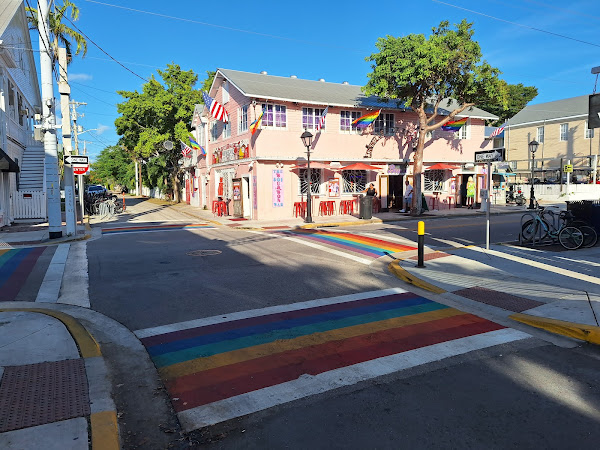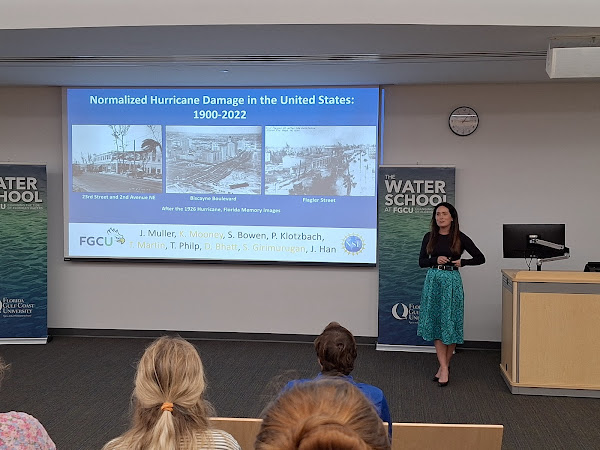Fall 2024 schedule:
1. Research and teaching at Florida Gulf Coast University
2. Hurricane Helene
3. Key West Classic paddle race
4. Hurricane Milton
5. Back to research and teaching
Life in Florida is *a lot* sometimes, in both good and bad ways. Rhonda and I have adjusted to the "downsizing" that Hurricane Ian forced on us in fall 2022, moving from a flooded then sold from under us rental house in Bonita Springs to a tiny but cute bedroom apartment in Estero. Positives include:
1. Bicycling a short distance to work and never having to worry about gas or finding a parking place.
2. Power-couple working from home vibes with two desks set up in a single room that is home office, living room, kitchen, and dining room.
3. Easy to walk the dogs within the apartment complex, nice neighbors, and a swimming pool.
4. Being at 5 meters elevation (as opposed to 2 meters) and therefore not having to worry about storm surge or freshwater flooding.
5. Rhonda discovered that there is just enough room over the kitchen cabinets to store my 14' race paddleboard, and we developed an efficient system now for getting it down and out the door, so I can paddle almost as much as I used to again.
There are some negatives, like it's a longer drive to the beach, we have no room for guests and no storage space for hobby stuff, and we can't make our own decisions about the landscaping. We're living well overall, though, and able to progress on some of our life achievement / enjoyment goals. For example, Rhonda is kicking butt with her writing and editing career, going on Disney World trips with her sister and nephew, and I am pursuing some semblance of chaotic balance of research, teaching, environmental activism, and watersports / fitness pursuits. The last month has been a particularly dramatic one, and that is the subject of this post.
It started out fairly normal: teaching and research. Fieldwork for the research has been fun. My colleague Melissa May and I are part of a team working with the Gulf Shellfish Institute to restore hard clams, aka Southern Quahog (Mercenaria campechiensis) by combining seagrass and clam restoration projects. Hard clams used to be ubiquitous in SW Florida, but they were massively overharvested in the 1960s and have been slow to recover, possibly due to loss of spawning stock. We've been diving in shallow waters and scoping out sites that currently have low amounts of clams and seagrass but could potentially be restored. In the picture below some Gulf Shellfish Institute researchers are hamming it up with a few clams we found during a site survey using the Sanibel Captiva Conservation Foundation's research vessel.
The bad stuff started with Hurricane Helene, which we were worried could be a reprisal of Hurricane Ian's devastating effects on our area. Helene was devastating for the "Big Bend" region of Florida between Tampa and Tallahasee, and almost apocalyptic as a "1000 year" freshwater flood event where my parents live in Asheville, NC.
The scariest thing for me about Helene was not being able to get in touch with my parents for days while watching apocalyptic footage of Asheville flooding, and imaginging them swept away in a mudslide somewhere. It turns out they were OK, and were able to evacuate to their beach rental house in South Carolina; an interesting reversal of the usual "head for the hills" thing you're expected to do in a hurricane.
Helene wasn't that bad for us in SW Florida, but it still managed to flood FGCU's Vester Marine Field Station enough that they had to remove drywall from where they had JUST fixed it post-Ian. The surges of Helene (and later Milton) show up well in this log from a water quality sensor deployed at the marine station by FGCU scientists.
Also, Helene flooded my paddle friends Justin and Bill's houses on the Imperial River and derailed their plans to attend the last ever Key West Classic paddleboard race. And it majorly resculpted the beaches and "sanded over" beach parking lots. I feel bad for whoever's cars and trucks these were that didn't get moved out of the Bonita Beach parking lots before the storm.
Some of the old Bonita Springs paddle racing crew were unaffected enough by Helene that we were still able to attend the Key West Classic. I drove down with Cindy Gibson and we met Meg Bosi and John Weinberg there, along with a bunch of other paddle racers from around Florida who we've gotten to know over the years.
Hawaiian style blessing before the 2024 Key West Classic.
For the race I'd been thinking about bringing my WIDE 14x27.25" Fanatic Falcon, but I didn't have the wherewithall to get it out of post-Ian storage at my buddy's house before the mess of Helene. So I ended up going with the beat up 14x23" Riviera RP that lives on top of my cabinets. The narrow Riviera board was perfect for the north side of Key West, where the water was flat in the lee of the south wind, but it was almost impossible to balance on the board on the wickedly choppy south side of Key West, where a residual wind and swell from Helene was bouncing off the cement seawalls. I especially suffered in in the final segment of the race where I kept falling and falling and was eventually passed by my most closely matched competitor Travis Kindt. Almost everyone else was also having balance issues, though, and many stand up paddleboarders ended up sitting down or kneeling on their boards to finish the race. Once the "sitters" were disqualified I actually ended up in third place, after Jake Portwood and Travis Kindt. My time was 3 hours 11 minutes, which is about 45 minutes longer than my best time from years past. Cindy won first place in the 12'6 board class and first place overall for the women, rounding in front of a bunch of younger women on 14' boards.
Jake Portwood first SUP finisher.
Me limping over the finish line.
Cindy Gibson finishing strong.
Meg Bosi.
After the race we ate good food and did a bunch of touristy stuff in Key West. Ernest Hemmingway's house was worth the money and the Key West graveyard, with all kinds of history, flowers and feral chickens and iguanas running amok was neat.
We didn't get much rest after Helene and Key West before the next hurricane loomed: Milton. With a more southerly track than Helene, it looked like it could be extremely bad for us, and maybe a "worst ever" scenario for Tampa Bay. As it was, the track kind of "threaded the needle," coming ashore just south of Tampa Bay and not causing much storm surge there, while being far enough north of my area that our storm surge was only a little bit higher than Helene's was. There were scary tornadoes across the whole state as Milton was approaching, though, for which Rhonda and I had to hide in the bathroom with our dogs. It also flooded FGCU Vester station ABOVE the line where the soggy new drywall had just been removed after Helene. Ugh. Bill and Justin's river houses also flooded again, significantly more so than in Helene, so they are in hell still. Areas north of me but south of Tampa Bay, like Venice and Sarasota, got it worst, with major surge, wind damage, and basically total devastation of the barrier islands and low lying areas.
I know I shouldn't get in the water after hurricanes, since it's like, 90% sewage and toxic waste, but yesterday Cindy and I carefully paddled through the backwaters from Bonita Beach road to Wiggins Pass State Park to check out the scene there. Interestingly, all the ingredients of nature: trees, sand, shells birds, fish, etc. are still there, just in significantly different arrangements. The parking lots of the state park are totally obscured under new sand dunes, and what once were forests are now roots and tree stumps awash in the Gulf of Mexico.
People keep talking about "build back bigger and stronger" but I think we need to be a little careful about how we approach that. In my opinion, we really shouldn't be building stuff that's supposed to last a long time on beaches and barrier islands. These areas move and shift around a lot, even when sea level isn't rising, and sea level IS rising (about 3.57 mm/yr in Fort Myers according to the NOAA gauges there). Besides the upward creep of sea level rise, another thing making us more vulnerable is the increasing temperature and "oceanic heat content" of the Gulf of Mexico, which is like rocket fuel for hurricanes. The gulf has been record hot for the last few years, and was 2-3 degrees Celsius warmer than normal for these last two storms, contributing massively to their convective winds and precipitation. Big, destructive hurricanes won't be hitting us EVERY year, but they're definitely going to be hitting harder and causing more surge and flooding than they did in decades past.
Between Helen and Milton my geology / meteorology colleague Dr. Joanne Muller gave a killer talk about hurricanes and her efforts to account for their changing impacts over time. Proud to be part of a scientific community that is looking at the science and economic impacts of storms with clear eyes.
Dirt roads, parks with hiking / biking trails, simple beach access areas, maybe some campgrounds; those are the only kind of human use things that I think really make sense for beach front and barrier islands of the Gulf.
January 5, 2026
4 hours ago





















